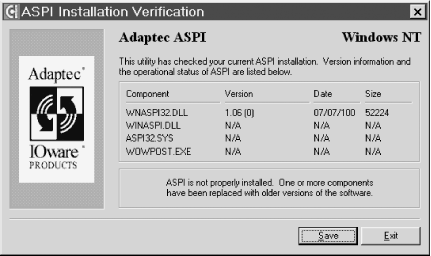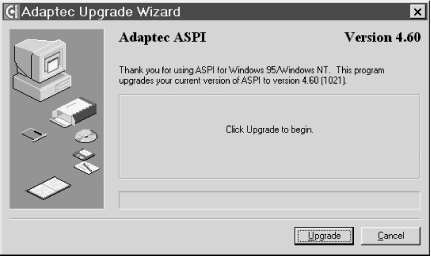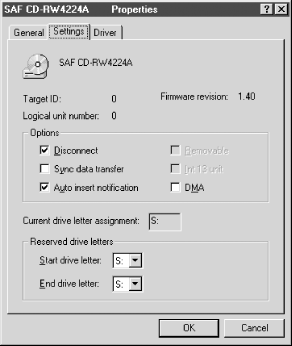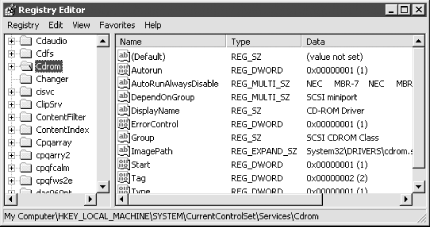11.12 Writable CD Troubleshooting
Troubleshooting writable CD problems is challenging. There are so many
things that can go wrong, and so many variables you can change to try
to fix the problem that it may seem the only choice is to strip
everything down to bare metal and start over. Such extreme measures
are not usually called for, however. In the course of working with
dozens of CD writers on many different systems,
we've encountered an amazing variety of problems.
The following sections describe how to cure those problems. If
you're having a problem with your CD writer, chances
are one of these fixes will cure it.
11.12.1 General Troubleshooting
Before you do anything else, take the following steps, which solve
most writable CD problems:
Read the manual. Sometimes the problem isn't really
a problem at all. It's supposed to work that way.
If you're writing to a new type (or even batch) of
CD-R discs, try a different type of disc. Many problems are
disc-related, particularly if you're using cheap
discs. When we think the problem may be media-related, we generally
try burning a Taiyo Yuden blank. If that fails, we look elsewhere for
the problem.
If the system is overclocked (or even just tweaked for maximum
performance), try setting things back to standard values. Burning CDs
is one of the most demanding things you can do with a system, and
even minor stability problems are likely to manifest during the burn.
If you're overclocking your processor, running PC100
memory at 133 MHz, running CL3 memory with CL2 timing, or something
similar, set things back to standard and try the burn again.
Check the manufacturer's web site for your CD writer
to see if they have posted a firmware update. If so, install it. In
addition to fixing bugs, firmware updates may add new capabilities
(such as the ability to write 80-minute blanks) and add support for
burning schema required by new types of media.
Check the software manufacturer's web site to see if
there's an update available. Most CD writer software
makers update their software frequently, and patches often solve
problems.
For an ATAPI/IDE writer, check the DMA status of the ATA channel that
the writer connects to. Some writers, even those that theoretically
support DMA, do not function properly if DMA is enabled. Others
don't work properly unless DMA is enabled. If DMA is
enabled on the channel, disable it, restart the system, and try
again. If DMA is disabled on the channel, enable it, restart the
system, and try again.
 |
On older systems, disabling DMA may not be enough. You may have to
uninstall bus-mastering drivers. Also note that disabling DMA on any
system may prevent you from burning CDs at high speed (8X or
higher).
|
|
Under Windows 95/98, the
file \WINDOWS \ SYSTEM \ IOSUBSYS \Scsi1hlp.vxd
supports legacy SCSI devices but sometimes causes problems with CD
writers. Rename or delete that file, restart the system to clear it
from memory, and try burning again. Check the ASPI version. All CD writers, ATAPI and SCSI, use
ASPI. You want the latest version available. If
you've installed new SCSI hardware and your CD
writer suddenly stops working properly, it's
possible that software setup for the new hardware installed an older
version of ASPI on top of your later version. This occurs more often
than it should. For example, we had a system with a CD writer that
operated perfectly. We installed a SCSI HP scanner on that system,
and suddenly the CD writer started producing coasters. When we
checked the ASPI version, we found that the current version had been
replaced with a 1997-vintage 1.x version of ASPI. To check the ASPI configuration, run
Start  Find Find  Files or Folders and
search for the file wnaspi32.dll on C: and all
subdirectories. Ordinarily, there should be only one copy of the file
on the system, and it should reside in the \WINDOWS
\SYSTEM folder (Windows 9X) or the \WINNT \
system32 folder (Windows NT/2000). If you find other
copies, delete them. Exception: if you have more than one operating
system installed, it is proper for a copy of the file to reside in
the system directory of each. Also, some CD-R software makers include
their own version of wnaspi32.dll with their
software. In that case, check with the CD-R software maker before you
upgrade from their custom version to a later generic version. Files or Folders and
search for the file wnaspi32.dll on C: and all
subdirectories. Ordinarily, there should be only one copy of the file
on the system, and it should reside in the \WINDOWS
\SYSTEM folder (Windows 9X) or the \WINNT \
system32 folder (Windows NT/2000). If you find other
copies, delete them. Exception: if you have more than one operating
system installed, it is proper for a copy of the file to reside in
the system directory of each. Also, some CD-R software makers include
their own version of wnaspi32.dll with their
software. In that case, check with the CD-R software maker before you
upgrade from their custom version to a later generic version.
You can determine which version of ASPI you have installed by
downloading and running aspichk.exe from
Adaptec. While you're there, download the file
aspi32.exe,
which is an ASPI updater. Running the ASPI check program displays a
screen similar to that shown in Figure 11-8 (note
the Y2K formatting problem). This program displays the current status
of ASPI, but changes nothing.

If your ASPI installation is out of date or munged, run
aspi32.exe to update ASPI to the current
version. Running the ASPI updater displays the screen shown in Figure 11-9 (although you'll probably see
a later version number). Click Upgrade to install the update, which
takes only a second. When the update completes, the updater prompts
you to restart the system to put the changes into effect.
 Ordinarily, the process
of updating ASPI is benign. Once or twice over the years, however, we
found that the newer version of ASPI caused problems of one sort or
another with the CD writer. In that case, the easiest way to revert
is usually simply to reinstall the CD writer software, which should
overwrite the existing ASPI driver with the older version bundled
with the software. If the preceding steps
don't solve the problem, one of the following may:
Try some other brand of
software. For example, one of our new writers came with Adaptec Easy
CD and DirectCD, both of which were supposed to work with Windows
2000. They didn't. We downloaded
Nero Burning ROM (http://www.nero.com) and installed it. A few
minutes later, we were merrily burning CDs at 16X under Windows 2000.
Don't assume that the software that comes with the
writer is necessarily the best software to use, or even that it will
work properly. It seems that the choice of bundled software is
sometimes made by the marketing department for reasons entirely
unrelated to functionality or stability. Eliminate any software that creates
virtual disk volumes. That includes not only packet-writing software
(like Adaptec DirectCD), but such things as UDF drivers for DVD-RAM
drives, the Onstream Echo backup software driver, and so
on—anything that creates a virtual disk volume with an assigned
drive letter. Unfortunately, when we say
"eliminate" we mean a bit more than
just uninstalling the software. In our experience, although
uninstalling may work, it's
more likely you'll need to either eradicate all
references to the problem software from the registry, or else strip
the disk down to bare metal and reinstall from scratch. If you're using an ATAPI
CD writer, check the IDE configuration. Always install the writer on
a different channel than the source drive(s) if at all possible. If
you do on-the-fly (CD-ROM to CD-R) copies, install the CD writer and
the CD-ROM drive on different channels. If you do indirect copies
(writing the data first to the hard disk), install the CD writer and
hard disk on different channels. The best configuration is generally
to make the hard disk Primary Master, the CD-ROM drive Primary Slave,
and the CD writer Secondary Master. This allows you to copy from
either the CD-ROM drive or the hard disk without having both source
and destination devices on the same channel.
 |
If your CD-ROM drive doesn't support
DMA,
putting it on the same channel as the hard disk may actually impair
your ability to burn CDs successfully. This is true because ATA does
not allow mixing DMA and non-DMA devices on a single channel. If you
install a non-DMA CD-ROM drive on the same channel as the hard drive,
that forces the hard drive to downshift from DMA mode to PIO mode.
PIO mode slows throughput and greatly increases CPU utilization, both
factors that contribute to coasters.
In this situation, we recommend
replacing the CD-ROM drive with a DMA-capable model or simply using
the CD writer as the sole CD device in the system. If
that's not possible for some reason, the best bet is
probably to put both CD devices on the secondary interface and always
copy data to the hard disk before burning. Note, however, that that
forces the CD writer to operate in PIO mode, which may limit the
upper speed at which you can burn CDs. Typically, writing at 8X or
higher requires DMA mode, some burners require DMA mode to do 4X
copies reliably, and nearly all burners require DMA mode to do 16X
copies.
|
|
Most IDE CD writers are
happiest as the Master (or Sole) device on the secondary ATA channel.
If you have two devices on the secondary channel and the CD writer is
set as Slave, try switching the CD writer to Master and the other
device to Slave. If that doesn't solve the problem,
try disconnecting the other device temporarily. Some CD writers
simply do not get along with some other devices on the same channel,
typically older IDE tape drives, Zip drives, and similar devices.
11.12.2 Specific Problems and Issues
This section describes some specific problems we have encountered and
the fixes for them.
- Test burn succeeds but real burn fails during TOC write
-
This is usually caused by Auto Insert
Notification or AIN (Windows 9X) or
Autorun (Windows NT/2000) being enabled on the
CD writer. The actual burn appears to proceed normally, but fails
during the TOC write phase. This occurs because Windows periodically
looks at CD drives. An unburned (or partially burned) disc contains
no TOC, and so is of no interest to Windows. But when the burn
process starts to write the TOC, Windows suddenly notices that a real
disc is in the drive and attempts to read it, killing the burn.
Most CD writing software controls the status of AIN itself, turning
AIN on or off as necessary. Generally, for proper functioning, CD
mastering software (e.g., Adaptec Easy CD Creator) requires that AIN
be disabled, while packet-writing software (e.g., Adaptec DirectCD)
requires that AIN be enabled. Properly behaved software generally
handles this automatically, checking AIN status when you start the
program, changing the status if necessary, and then returning AIN to
the original status when you exit the program. However, not all
software is properly behaved, and confusion can occur if you use a
mastering package and a packet-writing package from different makers.
For some CD writer software (e.g., Nero), AIN status
doesn't matter.
To check or reset AIN status under Windows 95/98, start Device
Manager, expand the listing of CD-ROM devices, and double-click the
entry for the CD writer to display the device Properties sheet. On
the Settings page, shown in Figure 11-10, use the
Auto insert notification checkbox to view or
change the status of AIN.

Windows NT/2000/XP makes it a bit more difficult to view and change
Autorun status, requiring a direct change to the registry to do so.
If you frequently need to change Autorun status in Windows
NT/2000/XP, you can automate the process by creating two small
registry files. Name them descriptively, something like
Autorun-on.reg and
Autorun-off.reg. To create these files, take the
following steps:
Choose Start  Run, type regedit
in the box, and click OK. Run, type regedit
in the box, and click OK.
Highlight HKEY_LOCAL_MACHINE\SYSTEM\CurrentControlSet\Services\Cdrom
(as shown in Figure 11-11).
From the Registry menu, choose Export Registry File to display the
Export Registry File dialog.
Verify that the Selected branch option button is selected in the
Export range section and that the
HKEY_LOCAL_MACHINE\SYSTEM\CurrentControlSet\Services\Cdrom branch is
selected.
Browse to the folder where you want to store the file, and type in a
descriptive filename that corresponds to the current status of
Autorun. For example, in the figure, Autorun is currently enabled
(set to a value of 1), so we'd name this file
Autorun-on. Click Save to write the file to
disk, accepting the default Save As type of Registration Files.
Back in Registry Editor, double-click the Autorun item in the right
pane to display the Edit DWORD Value dialog. In the Value data box,
change the value from 1 to 0 (or 0 to 1, as appropriate) and click
OK.
Repeat Steps 3 through 5 to save the second file.

Following these steps yields two files named
Autorun-on.reg and
Autorun-off.reg. To change the status of
Autorun, simply double-click one or the other from Explorer. Windows
NT/2000/XP prompts you that you are about to add the information in
the file to the registry. Click Yes to change the setting for
Autorun. Windows prompts you that the change has been made
successfully. Click OK to clear the dialog. Autorun is now set to the
value specified by the file. If you change Autorun status frequently,
it's worth creating desktop shortcuts to each of
these files.
 |
It does no harm to reset Autorun from 0 to 0 or from 1 to 1, so you
needn't check before running one or the other of
these files. Simply double-click the one that sets Autorun to the
value you need at the moment.
|
|
- Test burn succeeds but real burn fails randomly during write
-
This problem is similar to the preceding one, but differs in that the
burn process may die at any stage during the write, rather than just
during the TOC write. Although there are many things that can cause
this problem, if you have eliminated the more likely causes, consider
the possibility of an inadequate power supply, particularly if you
recently upgraded the system with a second hard disk, faster
processor, more memory, or something else that places an additional
burden on the power supply. CD writers require significantly more
power during an actual write than during a test write, and an
inadequate power supply may be able to provide the current required
for a test write, but not an actual write.
- CD writer rejects blanks
-
If the writer immediately ejects a blank disc, there may be a media,
environmental, hardware, or software problem. To eliminate media, try
inserting a different brand of blank. If that disc is accepted, it is
likely the problem disc was defective or previously written (some
drives and software reject coasters without a helpful error message).
To eliminate environmental causes, verify the writer is not
overheating and, if it is an external unit, that it is level. If you
have recently added or changed hardware, verify that all cables and
jumpers are correct and, if the writer is SCSI, that termination is
set properly. Finally, if you have recently added software or
hardware to the system, verify that AIN, DMA, and so on are
configured properly and that ASPI is the correct version. If all of
those seem correct, uninstall and reinstall the CD writer software.
If all else fails, reinstall the operating system. If that
doesn't work, chances are the CD writer needs to be
repaired or replaced.
- The CD writer reports a power calibration, PCA, or write schema error
-
Different types of discs require the writing laser to use different
power settings and methods of writing to the disc. Every CD-R blank
includes a special area called the Power Calibration
Area (PCA), which the writer uses to test laser power and
other write parameters before actually writing data to the disc. PCA
errors occur when the writer can't determine how to
write to a particular type of disc, or occasionally when the disc
itself is defective. If you get a PCA error, try substituting a
different type of disc. If that works, try another blank of the same
type as the problem disc. If that works, the problem disc itself is
defective. If other discs of the same type also return PCA errors,
those discs are incompatible with your writer. Updating the writer
firmware may allow it to use those discs, but some types of discs are
simply incompatible with some types of writers. If the writer
sporadically or reproducibly returns PCA errors with different types
of discs, an inadequate power supply is the likely cause.
|






